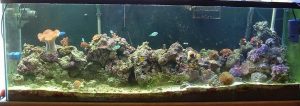A selection of useful tidbits of information for the aquarist. Readers are encouraged to send their tips to [email protected] or to post them to our Hot Tips sticky in the Reefs.org General Reefkeeping Discussion forum for possible publication. Next month’s Hot Tip theme will be “Sump Tips“.
Powerhead Hiding Tips
A few things I’ve used:
- Powerheads inside overflows, with holes cut for the return.
- Closed loops with hidden intakes and returns.
- Plumbing returns through the canopy, and having them sit just above the water surface but pointing at the corals. If done right you can’t see them. The drawback is that you get some bubbles.
- A lot of folks like to see their water surface “rolling”. An easy way to do this is to point airline tubing from a powerful air pump across the water surface from inside the canopy. A strong fan will work too, but takes up a lot of space.
- Under-sandbed plumbing. Never done this myself but it looks fairly simple.
— Matt Wandell
Behind some liverock. When stacking your live rock, leave an area for the power head to be placed in or behind it so that it’s blocked from the most common viewing side of the tank.
— “Supaboy”, “LordNikon”, and “l98-z”
- Take a small, flat piece of lr, mebbe 4″ across(or whatever size is needed to hide the particular powerhead),and 1/2-3/4″ thick. Bore a hole in it’s center, or thereabouts, just a hair larger in diameter than the powerhead’s output spout, and fit the spout through the hole, so that you end up with a ‘plate’ surrounding the spout, that lies perpendicular to the spout’s plane. The powerhead is now hidden behind it’s own mini ‘rock face’, independent of the rest of the rockwork, so it can be moved easily, if necessary, while retaining it’s camouflage, and eliminating the need to rearrange the existing lr structure of the tank
- Coating a powerhead w/silicon glue and coating it in some smallish shell pieces, and/or coral rubble also works well, as will superglueing a star polyp colony onto the top
— “Vitz”
You can go to lowes or the ever popular home depot and get some plastic painted pond rocks, snip them to size and silcone them the the powerhead. Then get a small amount of mesh screening to put over the outlet of the powerhead and paint it with some marine enamel paint (if you are a pretty good artists there are many tutorials online to painting rock patterns). You could also camoflauge the powerhead itself by priming and painting it with marine paint (again refer to the online tutorials for rock painting) the only drawback to this is you would have to breakup the outline of the powerhead by stacking rocks upto it and around it. The best idea however is just to epoxy live rock all over the sucker it will all but vanish this way.
— “Tackett”
Before you put the powerheads in the tank scrub them with a fine grade of sandpaper, algae will colonise it much faster and make it look alot more natural.
— “jackjackjack”
Use large (tall) rockwork to hide pumps, use suction cups if it allows you to attach to the back of the tank lower down, and not the traditional sides and high. Here’s a shot of my tank, with 3 seio 620’s:
Can you see the 3? There’s one on the far right, one on the far left (closer to the glass), and there’s one directly behind that rockwork on the right between the sump return pvc (haven’t found a way to hide that yet 🙂 ), and heater, you can see the head just barely poking out.
(yes i realize the rest of the tank isn’t exactly the best looking, but its a constant work in progress 🙂 )
— “sfsuphysics”
Try using a rubber band to attach some zoanthids to the powerhead. The polyps also securely anchor the powerhead to the glass. Just make sure you keep the intake clear! It takes a few months, if they’re growing well. It helps to start with a good sized “sheet” of polyps. I kept the bottom part clear, so when it needed cleaning I just removed the nozzle and impeller and left the motor housing in the tank. I used one of those little tube cleaner brushes with the flexible stem to clean the impeller hole. Then again, it never got jammed while I had the powerhead up.
— “Ken”



0 Comments